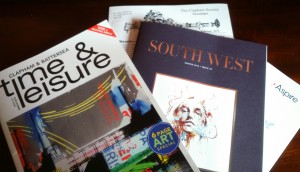This week I’m spending lots of time on publicity for the launch of ‘The Village; A Year in Twelve Tales’ on April 6th.
 The availability of ‘print on demand’ and access to the on-line markets, for both ‘e’ and printed books has revolutionised the publishing process, enabling small, independent imprints, like The Story Bazaar, to spring up and even flourish. But there remains the issue of getting attention for a book. It’s even less likely, at item three hundred and eighty-four on the Amazon, Fiction, Short Stories list, to grab the notice of a casual browser than it might as a physical book on a wooden shelf in a book shop ( even a shelf at the back, in the less well-lit part of the shop ).
The availability of ‘print on demand’ and access to the on-line markets, for both ‘e’ and printed books has revolutionised the publishing process, enabling small, independent imprints, like The Story Bazaar, to spring up and even flourish. But there remains the issue of getting attention for a book. It’s even less likely, at item three hundred and eighty-four on the Amazon, Fiction, Short Stories list, to grab the notice of a casual browser than it might as a physical book on a wooden shelf in a book shop ( even a shelf at the back, in the less well-lit part of the shop ).
Stats show that most Amazon, or other ‘e’ bookstore, browsers only ever look as far as the third screen or page before they either buy or go elsewhere. If your book isn’t on those screens it isn’t going to get in front of the eyes of a potential buyer. Amazon rank their books according to sales. So the more a book sells, the higher it climbs up the rankings on to the coveted top three pages. The books appearing on the first page of Amazon’s ‘Best seller’ or even its ‘Thriller’ category will probably be selling over 10,000 copies a day – the Robert Ludlums and Dan Browns of this world. This is a global market. So what hope for the unknown author?
Well, first, Amazon and others segregate books into categories and sub-categories, so a book may have a better chance of getting into the coveted top three pages in a sub-category like ‘Sea Stories’ than it ever would in ‘Literary Fiction’. And there is evidence that regular buyers from on-line stores use these sub-categories – people like to know what they’re buying. So getting your category right is important. Second, it really is all about sales, not how well-known an author is or who they know, so there is no snobbery and there are no pre-conceptions about a book. Good, sustained word of mouth can generate sales and drive a book up the rankings. This means a premium on quality, a deep understanding of one’s market ( usually niche ) and an inversion of the traditional, one-off ‘book launch’ strategy, as Amazon calculates ranking based on the previous weeks sales and a book can go down as well as up the rankings ( more on that later ). Third, good on-line reviews will also get a book noticed. Amazon will occasionally highlight the best reviewed books in its ‘Most Popular’ promotions. So I hope that everyone who enjoys ‘The Village’ will write a review on Amazon or other retailers, or on reader’s sites like Goodreads. I’ll be putting a link to review sites in the back of all of The Story Bazaar books, just to make it easy.
Encouraging sales and therefore increasing the likelihood of more sales, as a book climbs that list to a higher ‘ranking’ and wider exposure, doesn’t happen ( unless the gods really are smiling on you ) without a great deal of planned activity. Traditionally books are ‘launched’ and the ‘e’ world is no exception to that. The accepted way of launching an on-line title is now to have a separate launch site – ‘The Village’ has one at www.thevillagedirect.com and I’ll be populating that as launch gets closer. But the surrounding publicity has to try to sustain sales over a longer period, the better to fit with how the Amazon algorithms work. Seven days great sales get you a high-ranking, but, if that isn’t sustained, you drop back down again soon. Any publicity strategy has to take into account how to drive up sales long after the first ‘buzz’ has passed. Fortunately there are ways of  doing that, which I’ll talk about when I do it.
doing that, which I’ll talk about when I do it.
For now I’m busy organising features in both free and paid local press. I’m setting up ‘Meet the Author’ events in local venues and the features will, I hope, generate interest ( it’s much easier to get press engaged if they’ve got something to photograph ). I’m exploiting my connections across the country too – in the Midlands, from whence I hail, friends and family are distributing promotional cards in local libraries and book shops ( most are happy to take cards or fliers ), likewise in the south-west where quite a lot of the rural detail in the stories comes from. Watch out for the ad in Public Service Magazine, those who get it.
But, in the end, it still comes down to word of mouth and that depends on quality and the willingness of readers to talk about books. And that, after all, can’t be a bad thing.


 RSS – Posts
RSS – Posts